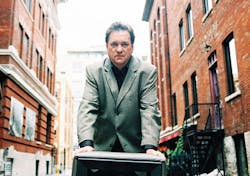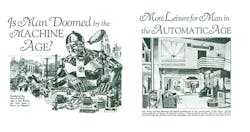Futurist Says "Fast & Furious" Changes Coming to Manufacturing
Jim Carroll, a former accountant and current author/corporate speaker, is confident he knows what's going to happen in the world of manufacturing. And the world-renowned Canadian futurist doesn't need a flux capacitor or any other sci-fi MacGuffin to make bold claims in front of millions about what technologies they need to adopt now, and what the world will look like for our children after we're rocketed to our Martian retirement homes—where our corpses will no doubt be used as fertilizer for space yams. (You're welcome, Elon.)
No, Carroll's trick is to absorb as much knowledge about technology's past and present, and combine that with critical thinking to make educated guesses on its future for NASA, GE, Lockheed Martin, and dozens of other global tech leaders. It's not as salacious as predicting robots will take our jobs and spouses, but the accomplished author has a track record for getting things right. He's the opening keynote speaker for the Canadian Manufacturing Technology Show in Toronto on Sep. 25, and he recently found some time for us.
NED: Why did you become a futurist and how does a person go about becoming one?
Jim Carroll: I'm actually a C.P.A. by background. You know from '79 to '89 I was with predecessor firms of KPMG and Ernst & Young. I was probably one of the first 1,000 guys in the world on the Internet and I wrote 34 book about the Internet in the '90s that sold a million books. That got me out there talking about future trends and what comes next. So much of the future is about technology and connectivity and it just sort of morphed into this broader thing of overall trends and innovation.
NED: What can you say was the first future prediction that you had?
JC: Probably the Internet of Things. I can go back to articles I was writing in 1993-94, that this world in which every device that was a part of our daily life is becoming connected to the big global machine known as the Internet. I was absolutely bang-on on. A lot of that is still coming true.
NED: What do you see happening with technology and what the world's going to look like in 10 to 20 years?
JC: We're in a situation in which companies that do not yet exist will build products not yet conceived using materials not yet invented with maybe manufacturing methodologies that don't exist fulfilling a customer need we don't even yet know. That's the way I view the future.
When I get in front of my audiences, the picture I paint for them is that everything's on the table, everything is coming out faster and we need to prepare for that. We can make these broad predictions of where we're going, but one thing is for certain: it's going to happen faster than we think.
One of my jokes on stage is, "We don't know where we're going but we're making great time."
NED: What technology would you say should people be right to be a little suspicious of?
JC: The hype du jour is that robots and artificial intelligence are going to take all our jobs and we'll need a government that gives us a guaranteed income supplement. I wrote a blog post in which I dig out these articles from Popular Mechanics and Popular Science magazines from the 1930s and 1940s that predicted giant robot brains were going to take away our jobs, and that machines were going to make us all unemployed. The 1950s and 1960s Reader's Digest issues I read about had computers that were going to lead to a world in which we'd all be working two hours, day two days a week.
We're going to have all the leisure time in the 21st century. Well, how'd that work out? There's a lot of hype and hysteria about robotics and AI right now. No doubt, there's a real trend, but people are carried away by the hype and hysteria. What they're not talking about at the same time is that while all these jobs disappear, there's the emergence of all kinds of new jobs, new careers, and new capabilities.
I mean, we used to make horseshoes, now we make tires, and what are we going to make next? The old skills are dead gone. Those jobs aren't coming back. There are new jobs, new skills, and more advanced skills. And everybody in manufacturing knows that.
NED: Do you ever think about how the next couple of generations, raised in the age of smartphones and unlimited information age, will deal with all these changes?
JC: I view the world through my kids, who are 22 and 24. They've never known a world without the Internet or mobile devices. A one-year-old can walk up to the TV and touch the screen and wonder why it doesn't respond as an iPad does.
During my speaking engagements, I ask the question, "How many of you, took computer courses that involved COBOL, BASIC, or FORTRAN?" A whole bunch of hands go up. We were freaked out by technology, because we saw the ugly side, while this generation has not. And so I think the defining difference is that they are far more willing to ingest and innovate with and work with new technologies and new ways of doing things. They're not burdened by the past in the same way that baby boomers are.
They don't have a hang-up that baby boomers have with technology.
NED: How do you think that's going to translate to the so-called future?
JC: Think about manufacturing and robotics. You'll have a 50-year-old guy or lady in the factory, and you bring these tools to help streamline processes and they say, "Oh my God! This is terrible that can take my job away. I'm done; I'm toast."
And somebody in their 20's is going to say, "cool." It's a much more agile workforce, much more willing to try new things.
NED: What is one of these new technologies people should adopt now?
JC: The whole trend towards rapid prototyping. I can design something in CAD/ CAM, I can send it to a 3D printing contract manufacturer, and get a prototype back to see if that works. If it doesn't work, redo the blueprints, and send it back. Boom, boom. All of a sudden I've got this iterative product design methodology. The old methodology was we had to figure out how to design something, commit to a production run, and bring it to market.
NED: Is this something that's going to exponentially improve the future innovations, because we have so many more people that are able to take engineering chances and it's not costing them as much in terms of time or resources?
JC: The coolest thing I saw in the last 24 hours was Elon Musk putting out this video done to very cool music from all the rocket failures. His tweet essentially said, "This is what it takes to get to a workable product." They celebrate failure. You look at that and go, "Wow, what a mindset!"
Obviously, for safety, security, supply reasons, quality control, etc., we can't do that through regular manufacturing, but we can do that with rapid prototyping and 3D printing, iterative design and testing base design, and all those types of things.
NED: So what other technology will play a big part in the factories of the future?
JC: I speak a lot with companies about the future of manufacturing and we talk about the Internet of Things. There's a lot of experimentation and a lot of belief that this is going to take us to a very new and real and different world of digitization of the factory. Where we are right now is real-time spotting of production defects with a lot of IoT-based technology through the supply chain in the manufacturing process. But there's still a lot more yet to come.
There's the business model change that is coming fast and furious with this very thing called 3discovered.com. And it's sort of like an Uber for 3D printing. You send me your CAD files and I'll line you up with a 3D printing manufacturer which can do it.
I think cobots are coming out very quickly. We're getting away from two-plane robotic capability to six or eight or 10-plane capability and more spatial awareness, because spatial technology is going along at a fast and furious pace. The return of Google Glass with the manufacturing focus. And I was with a welding group doing virtual welding. I think we're going to witness all kinds of fascinating capabilities there very quickly.
NED: What about securing all this technology? Could that be a real issue, or is that more fear-mongering?
JC: No. It's real. I'll say two things: Equifax and South Park. Part of the Equifax problem happened because an employee portal as I understand it in Argentina was protected with the default user ID password combination of "admin" and "admin." Companies don't put enough senior-level perspectives on security. That's number one.
The second thing is you know we're still in the area that we're not really thinking through where it takes us. In the South Park season premier that aired the other night, the characters were doing Amazon Echo commands throughout the show and they were ordering products. People were discovering products were being added to their Amazon checkout boxes. They were setting alarms for people at really weird hours in the morning, they were turning up their Nest thermostat to 110°F.
To me, this is the most hilarious story ever. No one ever thought about this and here it takes a cartoon to come along and show us this glaring massive security weakness. The issues are huge and I think we've really only begun to scratch the surface of what's going to happen.
NED: If there's one thing people should know about the future, what is it?
JC: I really try to leave people with this message: Some people see a trend and see a threat. Innovators see the same trend and see an opportunity. There's a huge opportunity for North American manufacturing to reinvent itself to compete in the world economy. We're not going to do it by building crazy walls and wishing that the job of the 1950s will come back. It's all about robotics, 3D printing, and mass customization.
About the Author
John Hitch
Editor, Fleet Maintenance
John Hitch, based out of Cleveland, Ohio, is the editor of Fleet Maintenance, a B2B magazine that addresses the service needs for all commercial vehicle makes and models (Classes 1-8), ranging from shop management strategies to the latest tools to enhance uptime.
He previously wrote about equipment and fleet operations and management for FleetOwner, and prior to that, manufacturing and advanced technology for IndustryWeek and New Equipment Digest. He is an award-winning journalist and former sonar technician aboard a nuclear-powered submarine where he served honorably aboard the fast-attack submarine USS Oklahoma City (SSN-723).






